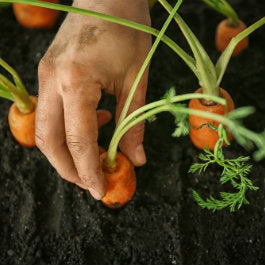
In the final throws of autumn, it’s a good time to sow cool-loving crops like parsnips, turnips and carrots. Fantastic all-rounders, root veg can be roasted, boiled, sautéed, mashed, eaten raw… With such versatility and variety in flavour it is well worth dedicating a whole section of your veggie patch to root crops, and to help you choose wisely we’ve teamed up with seed and bulb experts Mr. Fothergill’s to put together this handy guide.
Sown directly into the soil, preparing a foundation for your root crop seeds to germinate in is essential to the success of your harvest. Root vegetables like space and well-drained, fertile soil, so work in plenty of good quality compost a couple of months before planting to get the soil in top condition. Once your crops are in, keep on top of weeds, watering and mulching and you’ll have a delicious harvest in no time.
NB: As tropical temperatures can have as much of an impact on these vegetables as frost, it’s important to check when the most suitable planting time is in your area before you start.
.jpg) Parsnip
Parsnip
The sweet, tender root of a parsnip is a wonderful veg to have on your plate throughout the year, though plenty of patience is required when growing your own as they can take up to 20 weeks from seed to harvest. A parsnip's creamy flesh and narrow shape closely resembles the carrot, and it can be treated in much the same way; roasted, pan-fried, mashed or boiled as a delicious side dish or meal accompaniment.
As parsnips form very long roots it’s important to cultivate the top 20cm of soil to ensure it’s free from rocks, stones and hard lumps before sowing any seeds. For most varieties, seeds should be sown thickly around 6mm deep in the ground in rows set 40cm apart. Water seeds well until plants are established, then gradually thin seedlings out to 20cm apart to give them enough room to grow. Tip: Most seedlings need a regular and reliable source of water to help them establish, and Hoselink’s Mini Sprinkler Kit is perfect for keeping soil moist around the clock with very little effort.
When to plant: Spring through to autumn
Time to harvest: 18-20 weeks
Varieties to grow: Parsnip Hollow Crown, Parsnip Gladiator F1, Parsnip White Gem (pictured left)
Turnip
Image credit
An often overlooked member of the root veg family, turnips were once as popular as the potato thanks to their easy cultivation and fast harvest. Round in shape and cream and purple in colour, turnips have a deliciously mild radish-like flavour with peppery green tops; tasty baked, mashed, stir-fried or roasted.
To grow, sow seeds around 1.5cm deep in rows set 40cm apart. Once seedlings are established, thin out to 15cm apart and keep well watered. If you live in a part of the country prone to frost, protect your seedlings with mulch and cover overnight. Don’t allow your turnips to become too large or they will take on an unpleasant spicy flavour.
When to plant: Autumn and early winter, depending on variety
Time to harvest: 6-10 weeks, depending on variety
Varieties to grow: Turnip Early Purple (pictured right), Turnip Gold Ball, Turnip Purple Top Milan, Turnip White Stone
.jpg) Carrot
Carrot
Alongside their sweet, fruity flavour, carrots have some impressive health benefits. No, they may not give you night vision or make your hair curl, but they do help to reduce cholesterol, improve digestion, help to protect the heart and boost oral health. An excellent source of vitamin A in the form of beta-carotene, carrots are perhaps one of the healthiest and most versatile veggies of all the root crops, able to be eaten raw straight from the ground as well as cooked in a number of dishes.
Easy to grow from seed in well cultivated soil, sow around 5-6mm deep in rows 30cm apart. As with parsnips, keep seeds nice and moist until seedlings are well established, then thin out to one plant every 10cm and water well. You can repeat sowing every two weeks for a continuous crop.
When to plant: Winter through to autumn
Time to harvest: 12-16 weeks, depending on variety
Varieties to grow: Carrot Baby Pak, Carrot Kuroda (pictured left), Carrot Manchester Table, Carrot Navarre F1, Carrot Chantenay Red Cored
Beetroot
Image credit.jpg)
Possibly one of the most versatile vegetables around, beetroot can be eaten raw, cooked or pickled in soups, salads, sauces and many other hot and cold dishes. Immune-boosting and packed with vitamins and minerals, including potassium, beetroot makes a healthy addition to any dish.
To grow, sow seeds around 12mm deep in rows 30cm apart. Repeat every 4-6 weeks for a continuous crop. Thin out to 10cm apart once established. Keep soil moist.
When to plant: Winter to autumn, depending on variety
Time to harvest: 10-12 weeks, depending on variety
Varieties to grow: Beetroot Moneta (pictured right), Beetroot Crimson Globe, Beetroot Cylindra (Forono), Beetroot Detroit
 Swede
Swede
Quite literally a cross between a cabbage and a turnip, the swede has a distinct look of its own with rough cream and purple skin and a vibrant yellow-orange flesh. Slow-growing, the harvested globe-shaped veg has a sweet, earthy flavour, most frequently steamed or boiled and then mashed with seasoning and a knob of butter.
Swede is a hardy root crop and grows well in most good soil types. Sow seeds 1.5cm deep, allowing 50cm between rows. Keep seeds moist until established then thin out as soon as possible to 25cm apart.
When to plant: Autumn and winter
Time to harvest: 20-25 weeks, depending on variety
Varieties to grow: Swede Virtue, Swede Best of All (pictured left), Swede Champion Purple Top









